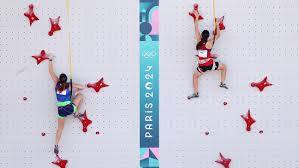Introduction
Sport Climbing Combined Olympics Indian: Sport climbing made its much-anticipated debut at the Tokyo 2020 Olympics, marking a significant milestone for the sport. Combining three distinct disciplines—Speed, Bouldering, and Lead—this new event captured the attention of climbing enthusiasts worldwide. However, while countries like Japan, France, and the USA have well-established climbing traditions, India’s journey in sport climbing is still in its nascent stages. This article delves into the complexities of sport climbing combined in the Olympics and explores India’s participation, challenges, and future prospects in the sport.
Understanding the Sport Climbing Combined Olympics Indian
Sport Climbing Combined Olympics Indian is a unique format that tests athletes across three different climbing disciplines, each demanding distinct skills.
Breakdown of the Three Disciplines: Speed, Bouldering, and Lead In Sport Climbing Combined Olympics Indian
- Speed Climbing is a head-to-head race where climbers scale a standardized wall of 15 meters as fast as possible. The fastest climber wins.
- Bouldering involves solving short but complex climbing problems on a 4-meter-high wall. Climbers aim to reach the top in the fewest attempts.
- Lead Climbing tests endurance, where climbers attempt to climb as high as possible on a 15-meter wall within a set time.
How the Scoring System Works In Sport Climbing Combined Olympics Indian
In the Combined format, climbers compete in all three disciplines, and their final ranking is determined by multiplying their placement in each event. The athlete with the lowest score wins, making it essential for competitors to be well-rounded across all three disciplines.
History of Sport Climbing Combined Olympics Indian
The road to Olympic recognition was long and challenging for sport climbing.
The Journey to Sport Climbing Combined Olympics Indian Inclusion
Sport climbing gained significant popularity in the 1980s, with formal competitions being held across Europe and North America. The International Federation of Sport Climbing (IFSC) was established in 2007, advocating for the sport’s inclusion in the Olympics. After years of lobbying and showcasing the sport’s appeal, the International Olympic Committee (IOC) officially added sport climbing to the Tokyo 2020 Olympic program.
Tokyo 2020: Sport Climbing’s Olympic Debut
The debut of sport climbing at Tokyo 2020 was a historic moment, drawing significant attention from around the world. The unique combined format, however, presented a significant challenge for athletes who specialized in only one or two of the three disciplines.
India’s Presence in International Sport Climbing Combined Olympics
India’s sport climbing scene has been growing steadily over the past few decades, albeit at a slower pace compared to other nations.
Early Beginnings and Growth of Sport Climbing Combined Olympics Indian
Sport Climbing Combined Olympics Indian began to take shape in the 1990s, primarily through the efforts of adventure clubs and the Indian Mountaineering Foundation (IMF). Over the years, sport climbing competitions were organized, and a small but dedicated community of climbers began to emerge.
Key Organizations Promoting Sport Climbing Combined Olympics Indian
The IMF has played a pivotal role in promoting sport climbing in India. By organizing national competitions, facilitating training camps, and supporting Indian athletes in international events, the IMF has been instrumental in laying the groundwork for the sport’s growth in the country.
Indian Athletes in Sport Climbing Combined Olympics
India has produced several talented climbers who have made their mark on the international stage.
Notable Indian Climbers on the Global Stage
Climbers like Tuhin Satarkar, Siddharth Uppar, and Bharath Karthikeyan have competed internationally, showcasing India’s potential in the sport. These athletes have participated in various World Cups and Asian Championships, gaining valuable experience against the world’s best.
Challenges Faced by Sport Climbing Combined Olympics Indian
Despite their talent, Indian climbers face significant challenges, including limited access to world-class training facilities, sponsorships, and opportunities to compete abroad. These hurdles make it difficult for Indian athletes to reach their full potential on the global stage.
Road to the Olympics: India’s Journey
Qualifying for the Olympics is no easy feat, especially for Indian climbers.
Qualification Process for Sport Climbing Combined Olympics Indian
The qualification process for the Sport Climbing Combined Olympics Indian involves participating in multiple international competitions, including World Cups and World Championships. Climbers accumulate points based on their performance, which are used to determine their eligibility for the Olympics. For Indian climbers, the journey is arduous, given the limited number of spots available and the high level of competition from other countries.
India’s Performance in Qualifying Events
Indian climbers have shown promise in qualifying events, with a few making it to the final rounds. However, the combined format’s demands have highlighted the need for more comprehensive training across all three disciplines.
Challenges for Indian Climbers in the Combined Format
India’s budding climbing community faces several obstacles, particularly in the Combined format.
Lack of Infrastructure and Facilities
One of the most significant challenges is the lack of infrastructure. India has few climbing gyms that meet international standards, and even fewer facilities cater to all three disciplines required in the Combined format.
Limited Access to Training and Resources
Training resources, such as expert coaches, climbing equipment, and exposure to high-level competitions, are scarce. This makes it challenging for Indian climbers to compete on an equal footing with their international counterparts.
Prominent Indian Athletes in Sport Climbing Combined Olympics
Despite the challenges, some Indian climbers have made notable strides.
Profiles of Top Sport Climbing Combined Olympics Indian
- Tuhin Satarkar: One of India’s most successful sport climbers, known for his speed climbing skills. He has won multiple national championships and has competed in World Cup events.
- Bharath Karthikeyan: Another prominent figure in Indian sport climbing, Bharath excels in lead climbing and has represented India in various international competitions.
Achievements and Milestones
Indian climbers have won several medals in Asian championships and have consistently ranked in the top 20 in international events. These achievements are commendable, given the challenges they face.
Indian Government and Climbing Associations’ Role
The Indian government and climbing associations play a crucial role in the sport’s development.
Government Initiatives to Support Climbing
The government has begun to recognize the potential of sport climbing and has taken steps to support its growth. Initiatives include funding for training camps, subsidies for climbing gear, and the construction of new climbing facilities.
Role of the Indian Mountaineering Foundation (IMF)
The IMF continues to be the backbone of sport climbing in India, organizing events, providing training opportunities, and helping climbers participate in international competitions. Their efforts have been critical in keeping the sport alive and growing in India.
Read More Sport Climbing Combined Olympics
Public Interest and Media Coverage
The popularity of sport climbing in India is gradually increasing.
Growing Popularity of Climbing in India
As more people become aware of the sport through social media and climbing documentaries, interest in climbing is growing. Urban climbing gyms are becoming more common, attracting a new generation of climbers.








